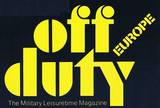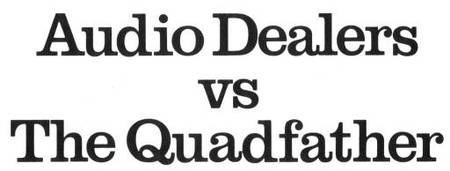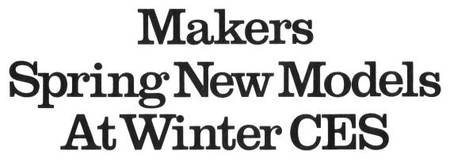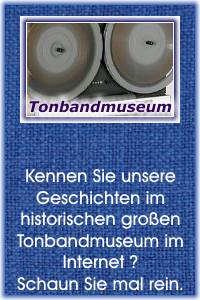"off duty" 1970 - 1997 - eine Freizeit-Zeitung für's US-Militär
Die in diesem amerikanischen (Freizeit-) Shopping-Magazin angepriesenen Hifi- und Video-Produkte waren auschließlich amerikanischen und kanadischen Militärangehörigen zugänglich - also zu kaufen - und vor allem zu ganz ungewöhnlich (verblüffend) niedrigen US $ Military-Preisen. Zu der einführenden "off duty" Seite geht es hier lang. - Um 1970 begann der weltweite Hifi-Boom bis zum 1. Crash 1978 und dann wieder zum 2.Crash um 1990. Über die 20 Jahre nach 2001 lesen Sie mehr in den Kolumnen auf diesen japanischen Seiten.
.
"Audio Dealers vs The Quadfather" - The 4-channel battle continues 1975 at Winter Consumer Electronics Show
"IS 4-CHANNEL NECESSARY?"
An audio dealer from Kentucky asked the question, and manufacturers at the Consumer Electronics Show (CES) agonized over the problem it exposed - the industry's failure to sell its dealers on the importance of quadraphonics.
Now a twice-yearly affair (in January and June), the CES in Chicago is the proving ground for audio's new products and the meeting ground where retailers, distributers and manufacturers air out their linen.
This year's winter renewal, with promotional hoopla well damped by the recession atmosphere, proved an ideal forum for the 4-channel skeptic who told a CES panel of experts, "We've been sold a bill of goods by this Quadfather."
Die Kontroverse über den Grund des Versagens der Industrie
Cause of the controversy is the audio industry's failure to agree on a unified approach to the marketing of 4-channel. A Sony engineer said, off the record, "I guess we should never have allowed the engineers to sell quad," rueing the fact that their battle over competing systems had been fought in a public arena instead of the laboratory.
The result? The quadraphonic medium has fought its way to recognition, all right, but retailers are bruised and battered and the public is dizzy from confusion.
Es gab nicht 1 Quadro-System, es gab derer 3 Systeme
Instead of one 4-channel system, there are three, and each must be explained to a public that wants to know what it's getting for its bread:
- CD-4 is the disc by JVC that, by means of a subcarrier, has four discrete signals in the groove. It's the system espoused by RCA and the WEA group comprising Warner Bros., Elektra and Atlantic labels.
- SQ is the matrix system developed by CBS, with the four signals reduced to two for recording or broadcasting, and unscrambled by a decoder. SQ has the lead so far in available recorded repertory.
- QS, the competing matrix system, by Sansui, is used by several independent recording companies and numerous FM radio stations broadcasting quadraphonically.
.
Wenn die Kunden verwirrt oder verar....t werden
The consumer's problem starts when he finds Barbara Streisand on matrix and Henry Mancini on discrete disc. He likes both performers but worries if his "universal" system will handle both types of discs.
Giant Zenith, now promoting 4-channel through its 2,500 TV dealers, wants to ease the customer's anxiety by getting away from type labels and calling it quad - period.
The retailer's cry that there is insufficient 4-channel "software" - means quadraphonic discs to play on the new equipment - to promote quad sound, is gradually diminishing.
Now there are enough record companies on the bandwagon to make a good showing - at least in the CES publicity handouts (also in den Prospekten !). But the angry dealer from Kentucky at CES was quick to point out that hardly ten percent of Billboard's Top 200 LPs are available in 4-channel, and only a fraction of the quad repertory appeals to the lively 18-34 youth market. Streisand and Mancini are not Gladys Knight and Elton John.
Alle 3 waren gezwungen, ihre Systeme schnellstens zu verbessern
The bright side of the JVC, CBS and Sansui face-off on systems is the rapid improvement in equipment a direct result of their competitive race.
While developing low-cost Integrated Circuit (IC) "chips" for their demodulators or decoders the competitors have added sophisticated new technology.
Performance, too, is far superior to that of early 4-channel designs. CD-4 now boats a phase-locked-loop circuit in the IC demodulator that makes the discrete disc less prone to carrier drop-out.
SQ offers full-logic chips while QS has Vario-Matrix, both achieving outstanding corner-to-corner separation with their latest decoder circuitry. Audiophiles buying new 4-channel receivers can get all three systems built in.
- Anmerkung : Auch hier wieder kein deutliches Wort, daß die ganzen Quadro Decodier-Varianten vor 1975 alle ziemlicher Murks waren, einfach nur effekthaschender untauglicher Müll.
.
Quadro über UKW (FM) - das würde helfen ??
Biggest deterrent to quadraphonic sales, say the experts, is the delay in full-scale broadcasting of the new sound. Discrete 4-channel on the airways is still awaiting a go-ahead from the U. S. Federal Communications Commission (FCC).
Several proposed systems were tested on KIOI in San Francisco and are presently undergoing FCC evaluation. Meanwhile, many stations are broadcasting a matrixed quad signal which doesn't require FCC sanction.
The industry's biggest mistake with quad, said one panelist at CES, was in trying to go too far too fast. There's a more sober approach today, as 4-channel digs in for a long-haul campaign to woo the public and especially the dealer. No longer is the New Sound billed as something revolutionary.
Now the word is evolution: a system that doesn't render present stereo repertory obsolete but, on the contrary, actually enhances it. The synthesizer circuitry built into the latest 4-channel equipment adds perspective to conventional stereo. "Suddenly all your records sound new," says the Quadfather. "Once you have 4-channel you wonder how you ever got along without it."
.
Makers Spring New Models At Winter CES
BY ROAMING THE CORRIDORS
..... of Chicago hotels in and around the Loop, audiophiles at the Winter CES got a sneak preview of some of the new products soon to be available in overseas exchanges and audio clubs. Most of the big-name component brands skip the winter show, which appeals mostly to the audio trade's "mass merchandisers," in Chicago for the giant Housewares Show.
But they take a hospitality suite at a nearby hotel to entertain visiting dealers and to give them an advance look at their latest product designs.
.
AKAI
AKAI is restyling its line with brushed chrome front panels on its tape-decks as well as its stereo and four-channel receivers. The Akai GX-270D is a new open-reel stereo model with three motors, solenoid controls and glass-and-crystal heads. Also new is model GX-230D, an auto-reverse deck with three motors and also three glass-and-crystal heads.
First Akai receiver with the new look is model AA-810DB, a popular-price receiver with built-in Dolby noise reduction. The Dolby system is dual process - that is, it includes separate circuits for recording and playback for use with 3-head tape machines. RMS power rating of the receiver is 10 watts per channel at 8 ohms with both channels driven from 20 - 40,000 Hz with not more than 0.08 per cent distortion. The receiver is also available without Dolby as model AA-810.
Six other Akai products featuring the new styling were also previewed. A new top-of-the-line cassette deck, model GXC-570D, is on the way featuring three motors, three heads, and heat-actuated touch controls.
Lower price cassette models will include the GXC-325D with three heads and the two-head GXC-310D. A new 8-track stereo cartridge tape-deck, model CR-83D, will feature an elapsed-time tape counter.
There will be a new open reel deck, model GX-265D, with three motors, four heads and bidirectional recording, and a restyled 4-channel receiver, model AS-1080, with built-in CD-4 and a 40 watt per channel RMS power rating.
.
BOSE
BOSE unveiled its first bookshelf design employing the direct-reflecting principle of its models 901 and 501. The new Bose model 301 will be sold in asymmetrical pairs so that the tweeter always faces to the outside and its energy is reflected off the nearest side wall.
The degree of reflection can be adjusted by means of a control built into each speaker. The model 301 has an 8-in. woofer and ported enclosure, a high efficiency design that will operate with amplifiers rated between 15 and 60 watts RMS per channel. Built into the design is a deliberate overlap of one octave in the frequency ranges covered by the woofer and tweeter. While the woofer extends up to 3,000 Hz, the 3-in. tweeter operates from 1,400 Hz upward. According to Bose, this "dual frequency cross-over" improves the speaker's sound spread by avoiding localization of the sound source at critical mid-frequencies. Stateside price of the new Bose 301 will be below $100.
.
EMPIRE
EMPIRE showed a restyled version of its floor-standing 3-way speaker system with 15-in. down-facing woofer. Known as the 9000GT, it has simpler, straighter lines than the original cylindrical model 9000. The new model is finished in walnut veneer with a smoked glass top. Stateside price of the Empire 9000GT is $329.95. (also nicht 8329.-)
.
JENSEN
JENSEN has four new loudspeakers and a new theme called "OPC," which stands for "Optimum Performance Concept". They feature a two-tone grill and a control panel on the front of each speaker, beneath a tinted, removable dust cover. The controls are color-coordinated with the speaker functions - blue for bass and warmer colors for the higher frequencies - in order to simplify adjustment of the level to suit the type of music or the acoustics of the listening area.
Jensen's model 21 is a 2-way system with 8-in. woofer and 2-in. cone-tweeter. Model 22 combines a 10-in. woofer with 2-in. cone-tweeter, while model 23 has a 10-in. woofer with l/2-in. dome tweeter. The top-of-the-line model 24 is a 3-way system with 12-in. woofer, 3-in. cone mid-range and lV2-in. dome tweeter and has twin controls on the front. The lower-priced models have a single control. Stateside prices range from $69 for model 21 to $179 for model 24.
.
KLH
KLH, too, has launched a new product series called "Research X," the initial entries comprising two loudspeakers and a turntable. The Research X "Column Bookshelf" loudspeaker, a 2-way system with 8-in. woofer and 2V4-in. cone-tweeter, is a departure for KLH because, instead of an acoustic suspension enclosure, it employs a vent for loading of the woofer, which KLH calls "Controlled Acoustic Compliance." The second Research X speaker, called the "Classic Four," has a 12-in. woofer in a sealed, acoustic suspension enclosure and features two dome-type tweeters in an angled configuration to improve high frequency dispersion.
The new model 60 turntable is a 2-speed, belt-driven, single-play design with automatic shut-off and tone-arm-lift triggered by a light detector resistor. Stateside price of the turntable is $150.
.
KENWOOD
KENWOOD featured "Super Stereo" at a private showing for dealers during CES, unveiling an extravagant ($1,350) loudspeaker system to match the 700 series of separate components introduced earlier.
The model 7 speaker is a floor-standing acoustic suspension 4-way system with 14-in. woofer, 4 1/8-in. dome mid-range, l 1/2-in. dome tweeter and 3/4-in. dome super-tweeter. The system weighs more than 120 lbs., and has a power handling capacity of 150 watts per channel.
There is also a new top-of-the-line stereo receiver, model KR-9400, rated at 120 watts per channel RMS at 8 ohms, from 20-20,000 Hz with no more than 0.1 per cent total harmonic distortion. As an extra front panel feature, the tuning system's signal strength indicator is a 3-function meter that also measures multi-path distortion and FM deviation. Stateside price of the KR-9400 will be about $750.
In the moderate-price category Kenwood has a new matched pair of separate components, the KT-1300G tuner and KA-1400G integrated amplifier, the latter rated at 14 watts per channel RMS at 8 ohms from 50 - 20,000 Hz with no more than 0.8 per cent distortion. There is also a new belt-driven manual turntable, model KP-1022, with a Stateside price of $119.95.
.
LECSON
LECSON is a new British company that made its Stateside debut at the winter CES with an amplifier and matching speaker systems of unusual design. The Lecson power amplifier is styled in the shape of a column, with all controls housed in a flat adjacent console with an array of color-coded slide switches. Lecson offers a choice of two power amplifiers, model API rated at 35 watts per channel, or model AP3 at 100 watts per channel, both ratings RMS with both channels driven at 4 or 8 ohms from 20-20,000 Hz and total harmonic distortion at 8 ohms less than 0.05 per cent.
There are two Lecson speaker designs, model SPI, a 5-way reflex system with two woofers, one of them mounted in the side of the column-shaped enclosure, and model HLI, a 3-way fully horn-loaded system that is also column shaped. The circuitry of Lecson's preamplifier includes a provision for 4-channel decoding, and the unit's electronic switching of functions also allows for remote control.
.
MAGNUM OPUS
MAGNUM OPUS is a New York- based loudspeaker manufacturer that builds a decibel meter into the front panel of one of its loudspeaker enclosures. Called the "db-tron Gauge," the meter indicates the actual decibel output of the speaker. Also featured is a construction that Magnum Opus calls "dynamic damping," employing an internal woofer to control the action of the speaker system's front-firing main woofer.
Two new models were introduced at the Winter CES. The Lab 800 has two 10-in. woofers (with dynamic damping), 15-in. mid-range, two dome tweeters, two cone-tweeters and one piezoelectric, a 4-way-system rated from 15 watts RMS minimum to 100 watts maximum. Model db tron 500 is a smaller 2-way acoustic suspension system with 10-in. woofer and 3 1/2-in. ring-tweeter, featuring a sound pressure level meter on the speaker's front panel and a built-in circuit-breaker to protect the loudspeaker in the event of overload.
.
SANSUI
SANSUI brought three super-stereo components to Chicago, the model CA-3000 pre-amplifier and a choice of two power amplifiers, all styled for professional rack mounting. The BA-6000 power amplifier is rated at 300 watts per channel RMS from 20 - 20,000 Hz with less than 0.1 per cent harmonic distortion, or 600 watts in mono.
Model BA-3000 offers 175 watts per channel (or 300 watts in mono) from 20-20,000 Hz with less than 0.05 per cent THD.
Also new from Sansui are three medium-priced components, the model TU-4400 tuner and a choice of two matching integrated amplifiers. Model AU-4400 is rated at 20 watts per channel RMS at 8 ohms from 40 - 20,000 Hz with no more than 0.3 per cent distortion while model AU-2200 offers 10 watts RMS at 8 ohms from 40-20,000 Hz with no more than 0.8 per cent distortion. All ratings are, of course, with both channels driven, in accordance with the new Federal Trade Commission regulations governing amplifier ratings. The AU-2200 is built by Sansui as an all~IC design with integrated circuits used in the phono equalizer, tone controls and power output section.
.
SONY
SONY is the first manufacturer to introduce production models of amplifiers employing new vertical field effect transistors (V-FET) in the power output stage. Unlike conventional bi-polar transistors, the FET has a high impedance, voltage-controlled input that gives it characteristics similar to a vacuum tube.
The new solid-state device has, according to some designers, an inherently low distortion characteristic that gives it a smoother, more natural tone quality than conventional transistors. Prototypes of new amplifiers employing the V-FET have been shown by several manufacturers in recent months, but most of the designs are still far from production because they require considerable change in other stages of the amplifier's circuitry.
Sony's initial entries are the TA-8650 integrated stereo amplifier rated at 80 watts per channel RMS at 8 ohms from 20-20,000 Hz with no more than 0.1 per cent total harmonic distortion, model TA-4650, rated at 30 watts per channel under the same conditions, and a basic amplifier offering 100 watts per channel under the same test conditions. They are part of a new series of super-stereo components that also includes the TAE-8450 preamplifier. A distinctive front panel feature of the new design is a horizontally-styled peak program meter for monitoring the power level.
.
SUPERSCOPE
SUPERSCOPE introduced a line of moderately priced loudspeakers. Model S-16A is a bass reflex system with 6V2-in. full-range speaker, priced Stateside at $69.95 per pair. Model S-26A, a 2-way reflex system, has a 672-in. woofer and 3-in. tweeter and a suggested Stateside price of $79.95 per pair. There are also four different air suspension designs: model S-208 with 8-in. woofer and 3-in. tweeter ($199.90 per pair); model S-210 with 10-in. woofer and 3-in. tweeter ($139.95 each); model S-212A with 12-in. woofer and 3-in. tweeter ($169.95 each) and the top-of-the-line model S-312, a 3-way system with 12-in. woofer, 4V2-in. mid-range speaker and 3-in. tweeter, priced at $199.95 each. All these Superscope designs are 8-ohm systems, and all feature removable foam grills.
.
TOSHIBA
TOSHIBA mostly featured its bread-and-butter of TV and portable radios at the winter CES, but in the rear of the exhibit there was a special showing of several new stereo components of advanced design.
A vertically-styled cassette tape deck, model PC-6030, is on the way, featuring servo-controlled direct-drive motor and IC logic. Toshiba also has three direct-drive turntables, the top-of-the-line SR-510 featuring light touch controls for speed changing. There are several new speakers, notably the SS-510 3-way system with 10-in. concave woofer, 43/4-in. concave mid-range and l3/ie-in. dome tweeter. Also shown was the new ST-510 stereo tuner, though the series' matching amplifier (SA-510, no doubt) was not included in the preview. Highlight of the Toshiba components exhibit was a far-out tuner, model ST-910, that features digital readout and a frequency synthesizer with automatic and manual scanning.
.
More New Goodies From the Winter CES - Teil 2
.
THE WINTER VERSION of the Consumer Electronics Show
THE WINTER VERSION of the Consumer Electronics Show (CES) in Chicago doesn't offer the broad range of equipment that appears at its summer counterpart, but is a good opportunity to spot trends and keep up-to-date with the Stateside market.
This year one of the most talked-about trends is the product upgrading resulting from the Federal Trade Commission's (FTC) new audio power output rating standards.
The Commission, and a lot of other folks, were upset with the exaggerated power claims of some manufacturers of audio equipment. After holding public hearings involving manufacturers, dealers and consumer advocates, the FTC issued rules requiring makers to reveal minimum RMS power per channel, load impedance at which the power is delivered, frequency range covered at the stated power and impedance, and the maximum amount of harmonic distortion from XU watt to full power.
Moreover, manufacturers have to arrive at these figures by using the specific test procedures established by the FTC. This includes an hour of pre-conditioning at one-third power with all channels driven by a continuous 1,000 Hz tone. That's more than an amplifier would ever sustain under normal conditions. As a lot of amplifiers fail to survive this preconditioning due to heat build-up, their makers will have to either reduce power ratings or add more heat sink area to the chassis.
Brand Expansion
More of the home entertainment "majors" are entering the audiophile marketplace. Zenith, GTE Sylvania and Magnavox are already advertising in some strictly audio publications. Now Morse, a successful maker of popular-priced equipment, is introducing its PSM component line with a top-end receiver costing $249.95.
Japan's Matsushita, parent company of Panasonic and Technics, will soon bring out another audio line under the Quasar label.
Mitsubishi, already marketing its own MGA and Onkyo lines, has just acquired the Pilot line.
As should be obvious from the above, many companies are taking on truely international markets. Harman International Industries, for example, of which Harman-Kardon and James B. Lansing (JBL) are already a part, now has acquired Tannoy of Great Britain. Other companies seem to be following much the same path, with many British and European companies already making, or planning to make, inroads into the U.S. market.
Hi-fi AM
Despite the quality of FM-stereo (and, perhaps, discrete quad one day soon), interest in quality AM listening is growing. A New Zealander, George McKay, Jr., has developed the $255.- Dymek AM tuner and the $155 Dymek AM antenna. McKay claims that some Stateside AM stations are capable of a frequency response from 30-15,000 Hz.
Tape (und die deutschen Maßeinheiten cm/s)
Pre-recorded tapes continue to compete with discs for audiophiles' favor. From Advent we have a series of Dolbyized, chromium-dioxide cassette recordings. Now Ambiphon Records of New York is producing a line of near "studio master" quality open-reel quad tapes at % 19.95 each. (Ambiphon also offers stereo records - for $12 each - that the firm claims have a 90dB dynamic range.)
In the blank tape market, Superscope, 3M and Fuji are offering combination chromium-dioxide/ferric-oxide tapes which, it is claimed, offer the advantages of both materials.
You may soon be finding some strange numbers on your blank tape, too, as the U.S. continues its slow march toward metric measurements. Instead of feet of tape, you'll buy by the meter. And, instead of in inches per second, tape speed will be measured in centimeters per second. Of course, in most other parts of the world these metric measurements have long been in use.
.
Consoles and Compacts
For those who want a furniture look, hi-fi console makers such as Soundesign are going all out. Typical Soundesign consoles feature AM/FM reception, BSR changers and 8-track cartridge players. Prices range from $179 to $300.
In the compact line, Morse has a pedestal-mounted system with the stem serving as a cartridge storage area and the speakers serving as hassocks. Brother International puts the turntable and the 8-track recorder/player each in an identical low-profile module. Prices start at $289.
Cassette and Cartridge
Cassette portables are challenging home-type equipment in terms of features. Sanyo's $149 M2470 receives AM/FM/ shortwave, has electronic memory rewind, a meter to show record level, signal strength and battery condition and a sleep timer. Hitachi's TRK 1500, also $149, has a chromium-dioxicle tape bias switch, lighted tuning dial and tone control. General Electric's Loud Mouth 3-5501 has a 6 1/2-inch woofer and 2 1/4-inch tweeter and costs $56.95.
Lloyd's MH-8570-9123 is a two-slot cartridge machine, one slot for recording and the other for playback. When recording it stops automatically at the end of the fourth set of tracks to prevent accidentally recording over the first tracks. This model sells for $299.
Sharp's RT-840 will record in stereo and play back both stereo and quad cartridges. It is $ 199 with two VU meters and minutes/seconds timer among other features. Another interesting hybrid is the $259.95 Miida SP65W that combines 8-track and cassette players in one unit and also includes a quad simulator.
Und damit brechen wir hier ab, es kommt nur noch Lowcost Schrott.
.





